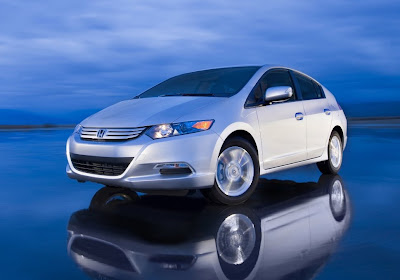
It was nearly 10 years ago that Honda shook up the automotive world with the then-new Honda Insight, the world's first mass-production hybrid electric vehicle. It looked like a CRX, packed a unique hybrid powertrain and set new standards for fuel efficiency. Honda revealed the 2010 Honda Insight Hybrid electric vehicle at the Paris Motor Show in October 2008. The Paris car was a ‘show’ version with LED headlights and 18 inch wheels that were never intended for the final production model. Honda plans to sell half a million hybrid vehicles annually by 2012 with the Honda Insight to account for 200,000 of those.
There's more than a subtle hint of Prius in the new Insight's 5 door bodyshell but following the poor sales of the Civic Hybrid, which was indistinguishable from a regular petrol power Civic, Honda have decided to follow the Toyota example and make a distinctive new aerodynamic Insight chassis that will only be sold as a Hybrid.
Mild Hybrid
While the Prius ‘look’ may score credibility points down at the local supermarket the 2010 Honda Insight is a much milder Hybrid than the 2010 Toyota Prius. Honda call their system Integrated Motor Assist (IMA), a simple system consisting of a small efficient gasoline engine, a continuously variable transmission (CVT) and a thin, brushless electric motor sandwiched between the two. Comparing the Honda and Toyota hybrid powertrain specifications is revealing. The Honda Gasoline engine is only a 1.3 Litre 8 valve VTEC compared to the 1.8 litre 16 valve VVT-I in the third generation Prius. Hondas in-line 4 cylinder engine puts out 88 hp (64 Kw) and 88 Ft/lb, the Toyota 98 hp (72 Kw). The electric motor in the Insight is an ultra thin Permanent Magnet AC Synchronous Brushless DC (BLDC) unit that puts out and regenerates only 13 Kw (10 hp) with 68 ft/lb (92 Nm). This doesn’t compare favourably with the Prius at 59kw (80hp) and 295ft/lb (400Nm). This alone earns the Insight the tag of ‘mild’ hybrid.
Another technical specification that no doubt keeps the price down but also classes the Insight as ‘mild’ is the 100 volt 0.58 Kw/hr battery pack. While it uses the same Nickel Metal Hydride (Ni-MH) Battery technology found in the Prius it has less than half the capacity as the 500 volt 1.3 Kw/hr Toyota pack. Honda say the 2010 Insight can be driven in EV only mode up to 30 mph (48 kph) on a level surface but with such a small battery it will probably give an EV only range of around 2 miles (3 kms). With a curb weight of 2723 lb (1235 kg) off the line the Insight does 0-60 mph in 10.9 sec and the quarter mile in 17.9 sec.
No plans for a Plug-In
While the the 18 inch wheels and LED headlights of the Paris show car are replaced by 15 inch wheels with low-rolling-resistance tires and more conventional Projector-Beam Halogen Headlights, the Insight does come with most of the features you would expect in a Hybrid. These include automatic idle stop, stepper motor controlled drive-by-wire throttle and electric power steering. Of course the most important factor for any hybrid is the fuel economy. The 2010 Honda Insight is rated at up to 43 mpg in highway driving so with a 10 gallon tank it gives a range of 430 miles (688 km) between visits to the fuel station. Unlike most of the other big names in Hybrids there has been no news on when a Honda plug-in hybrid will be offered.
With an electric motor 1/8th as powerful and a battery 1/2 the size of that found in the 2010 Prius, the Honda has a specification designed to low ball the Toyota competition while still making a decent profit. The 2010 Honda Insight has already made it's place in the history books by becoming the first Hybrid to top the Japanese sales charts in April but the jury is still out on if lower powered Hyrids will prove satisfactory in the long run.
skip to main |
skip to sidebar
Headings
Airbus
Apple
Aston Martin
Atieva
Audi
Axial Flux
Battery Electric Car
Battery News
Bentley
BMW
Bosch
Brammo
Bugatti
BYD
Car Sharing
Citroen
Coda
DIY
Drayson
Dyson
eAxle
Electric Bike
ELMOFO
EV Aircraft
EV Boat
EV Bus
EV Concept
EV Technology
EV Truck
EV Van
EV World Record
F1
Ferrari
Fiat
Fisker
Ford
Formula E
Foxconn
Freight EV
GM Bolt
GM Volt
Holden
Honda
Hybrid
Hyundai
Jaguar
Kawasaki
KERS
Kia
lamborghini
LG Chem
Liebherr
Lotus
Mazda
McLaren
Mercedes
MiEV
MotoCzysz
Motorsport
Nissan
Oil
Peugeot
Politics
Porsche
Power Plaza
Renault
Renewable energy
Renovo
Reva
Rimac
Rolls Royce
SAAB
Samsung
SEAT
SIM-Drive
Smith Electric
Solar Car
Subaru
Tesla
Test Drives
Torque Vectoring
Toyota
TV
Venturi
Volvo
VW
Wheel Motor
Wireless Power
WSC13
X-Prize
Yamaha
 Follow EV News on Twitter
Follow EV News on Twitter
2 comments:
Lets see are we sure we wish to talk about hybrid vehicle, is adopting to hybrid vehicle really a solution and if the era of hybrid vehicle would only be a transiently phase then do we really need to invest into a temporary solution....and why alternate & better solutions being delayed...
man you make no sence
Post a Comment